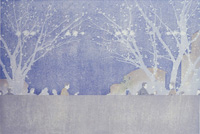 |
Natsuko Katahira
Close the eyes
2007
water-based woodcut on Japanese paper
57.9×86.5 cm ed.10
|
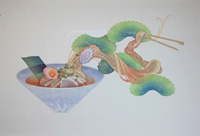 |
Shoji Miyamoto
Sample
2015
water-based woodcut on Japanese paper
50.0×80.0 cm ed.7
|
|
Kurumi Wakaki
Sample
2015
water-based woodcut on Japanese paper
50.0×80.0 cm ed.7
|
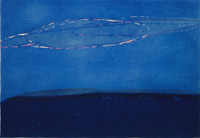
|
Megumi Mizutani
holding the wind
2002
water-based woodcut on Japanese paper
35.5
×51.0 cm ed.15
|
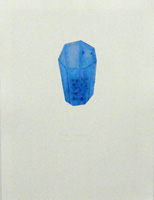
|
Kyoko Sasaki
Cheers
2015
intaglio, aquatint, etching
13.0
×8.0 cm ed.25
|
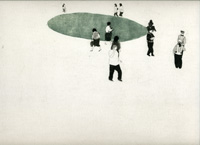
|
Ai Hori
info-ppongi
2008
etching, aquatint
23.0
×46.0 cm ed.10
|
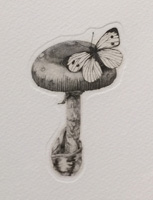 |
Kana Nemoto
garden -mushroom- ♯2
2015
etching, aquatint/Ganpi paper, Velin Arches
9.0×5.0 cm ed.20
|
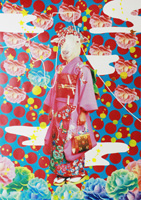 |
Airi Mizuno
KOTOBUKI IWAI
2016
ink jet print, lithograph, stencil
80.0×56.0 cm ed.15
|
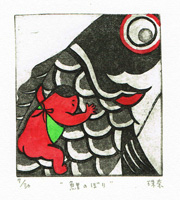 |
Tamana Araki
Kinobori
2012
etching, aquatint, hand -coloered
8.4×7.5 cm ed.30
|
| |
| |
|
Exhibition
The London Original Print Fair 2016
The Royal Acadmy of Arts
My5 (thu.) ー 8 (sun.), 2016
About Exhibition
Gallery Jin participates in The London Original Print Fair 2016.
We hope that visitors could enjoy the prints of Natsuko Katahira, Shoji Miyamoto, Kurumi Wakaki, Megumi Mizutani, Kyoko Sasaki, Ai Hori, Kana Nemoto, Airi Mizuno and Tamana Araki.
Natusko Katahira:
Time goes indifferently, while our experiences and information are piled up.
The memory gradually fades away.
I don’t want to forget trifles. The feeling of the past and her face in profile….
Wind brows, and trees stand still. There is a pathway to home.
Neatly organized the edge of the eaves. Each of them has an ambiguous boundary,
Always trying the best to welcome someone.
1983 Born in Kagoshima,Japan
2008 M.A.JOSHIBI University of Art and Desing
Shoji Miyamoto:
I make artworks that feature familiar foods, by using traditional Japanese techniques of
water-woodcuts.
Not to mention the unique shades of colour, but also I feel that restrictions or inconveniences by making woodcut prints would also bring unexpected attraction to the motifs. I am happy if people who see my work could find interesting things that are overlooked in their daily lives. As for me, I would like to discover those things by making art.
1988 Born in Osaka, Japan
2010 B.A. Osaka University of Arts
Kurumi Wakaki:
The marathon race started at 4 am.
The deep darkness of town without any lights starts to have colour as morning comes.
I take one indigo plate and another green plate.
My woodcut cannot compete with the great nature printed off without any mistake.
As I gave up trying to reach perfection, I started feel relaxed.
1985 Born in Osaka, Japan
2008 B.A. Kyoto City University of Arts
Megumi Mizutani:
When making prints, we do not draw the images directly on the paper.
This makes my artworks become better than my very first image,
because they are influenced by the wood or the washi(paper), which helps and gives
chances to change the whole work. I think this fact resembles our life. We live by the help, and sometimes by the suffering, given by people and the nature.
1973 Born in Chiba, Japan
2000 M.A.Tokyo University of Arts
Kyoko Sasaki:
The blue colour we see in the works of Hokusai or Hiroshige’s Ukiyo-e, is the colour that tells us
the deep story which lies in our casual daily life.
In order to express that sense when we look at the colour blue,
I feel that I could draw the shapes of my mind, not only by myself,
but also by collaborating with things that was accidentally given during the process of making editions of woodcuts.
(I hope that small stories of daily life would spread among people, just like a tuning fork.)
1972 Born in Shizuoka, Japan
1999 M.A.Musashino University
Ai Hori:
People look so small like toys, dotting the scenery.
We do not know much about what they are doing even if we watch their moves.
We have no idea about what they talk, what they think, and what they are trying to do..
I think that my prints are traces of my imaginations.
1982 Born in Tokyo, Japan
2007 M.A.Musashino Art University
Kana Nemoto:
I cherish the monochromatic world of copperplate engraving, and the process of making engravings
by dotting, and inscribing the plates carefully as if to note the time.
As for me, copperplate engravings are the tools to express my memories, experiences,
and times that I spent. I make works that could make people feel my stories.
1984 Born in Saitama, Japan
2013 M.A.Musashino Art University
Airi Mizuno:
My artistic theme is the indescribable feelings.
We all become impatient when we are unable to tell our own feelings to someone.
We all have negative feelings such as sadness. I want to make works that doesn’t show off those emotions but instead shines brightly as if nothing is bothered.
I am eager to make art by mixing different styles of ink-jet print and engraving.
1991 Born in Chiba, Japan
2016 M.A.JOSHIBI University of Art and Design
Tamana Araki:
I have been making installational works together with copper engravings.
These two different types of work intersect each other as an artistic theme and also as a medium.
In making copper engravings, I appreciate expressing what I want through overcoming technical difficulties and restrictions as a two-dimentional medium.
1970 Born in Tokyo
1997 B.A. Musashino Art University
|
![]()